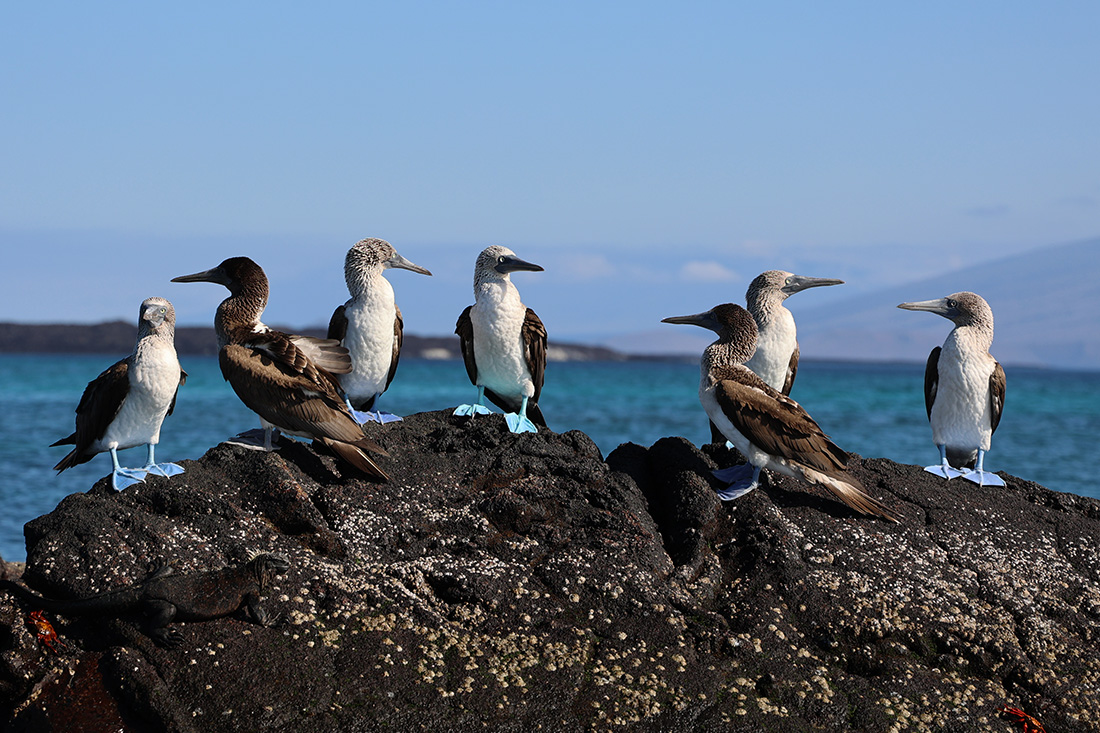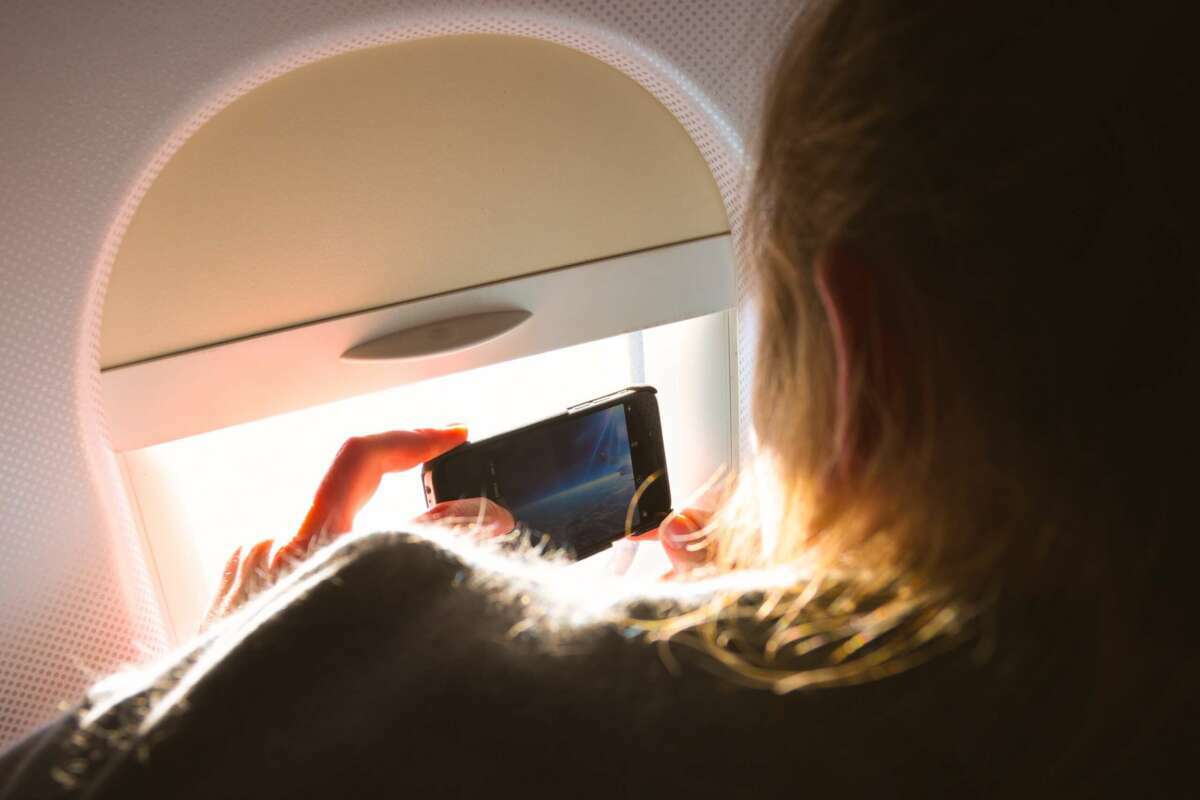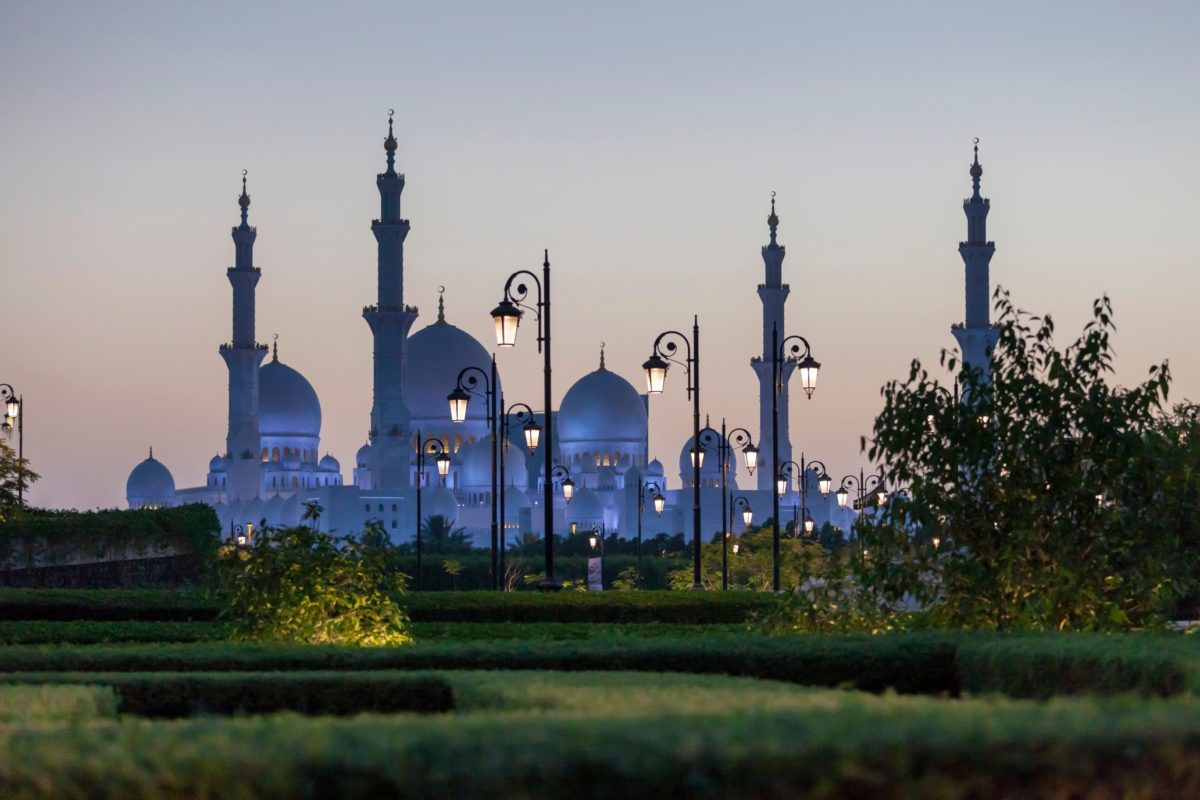On a recent vacation visit to the Galapagos Islands, we were treated to a morning out on the waters of Punta Mangle on Fernandina Island, a fresh, sparkling and fun place that also happens to be perfect for bird watching. We’re sharing highlights and our best photos from Punta Mangle in the Galapagos Islands, home to indigenous birds like Blue-Footed Boobies, brown pelicans, Flightless Cormorants and penguins, along with sea lions, iguanas and more.
Where is Punta Mangle located?
Fernandina Island is the youngest and one of the most active volcano sites in the Galapagos archipelago. The Punta Mangle cove sits on the island’s western coast, and its vibe reflects its relative youth. The day we sped through the cove on a Zodiac, it felt like there was a party going on.
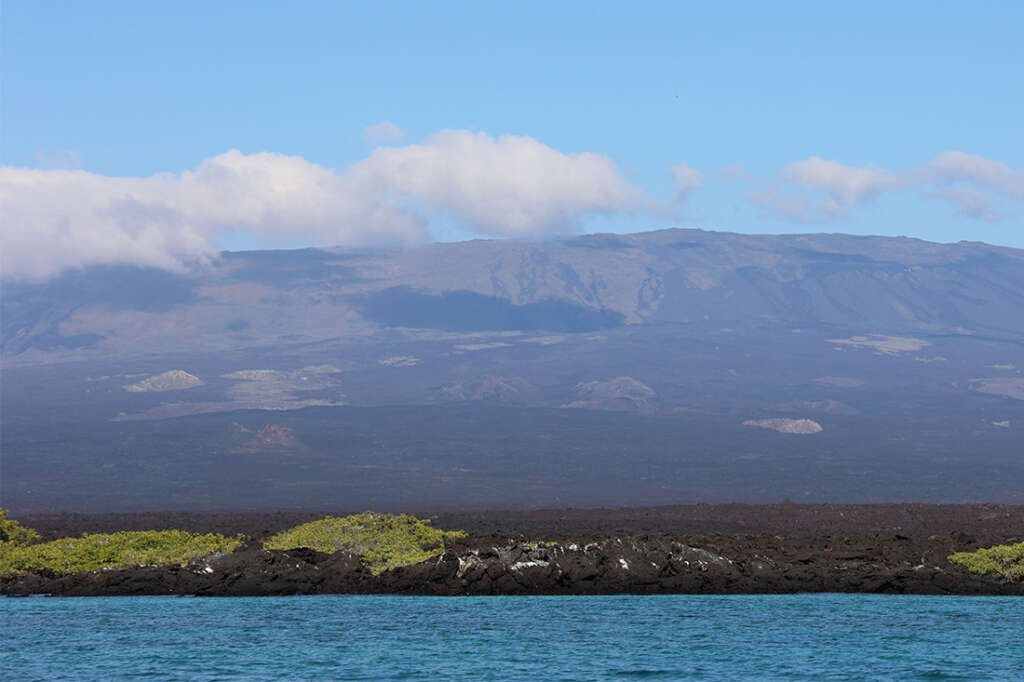
Punta Mangle in the Galapagos Islands. Photo ©Dandelion Chandelier.
First, there’s the gorgeous unspoiled surroundings. The Punta Mengle peninsula was formed by black lava flows that are covered in part by mangroves. The combination makes for stunning vistas in the water and onshore.
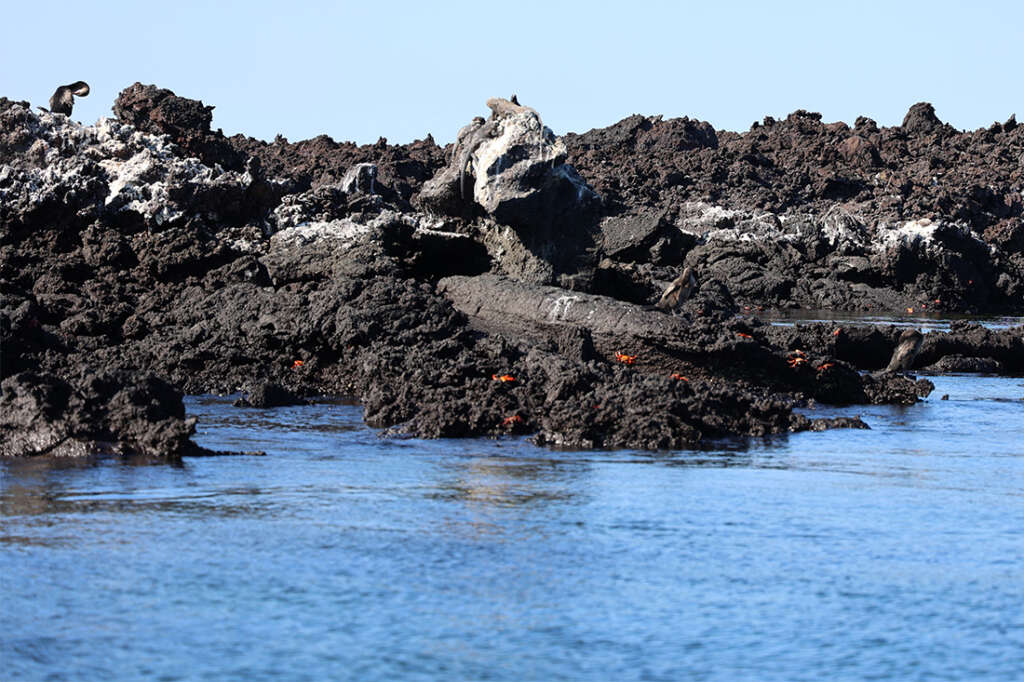
The bay at Punta Mangle in the Galapagos Islands. Photo ©Dandelion Chandelier.
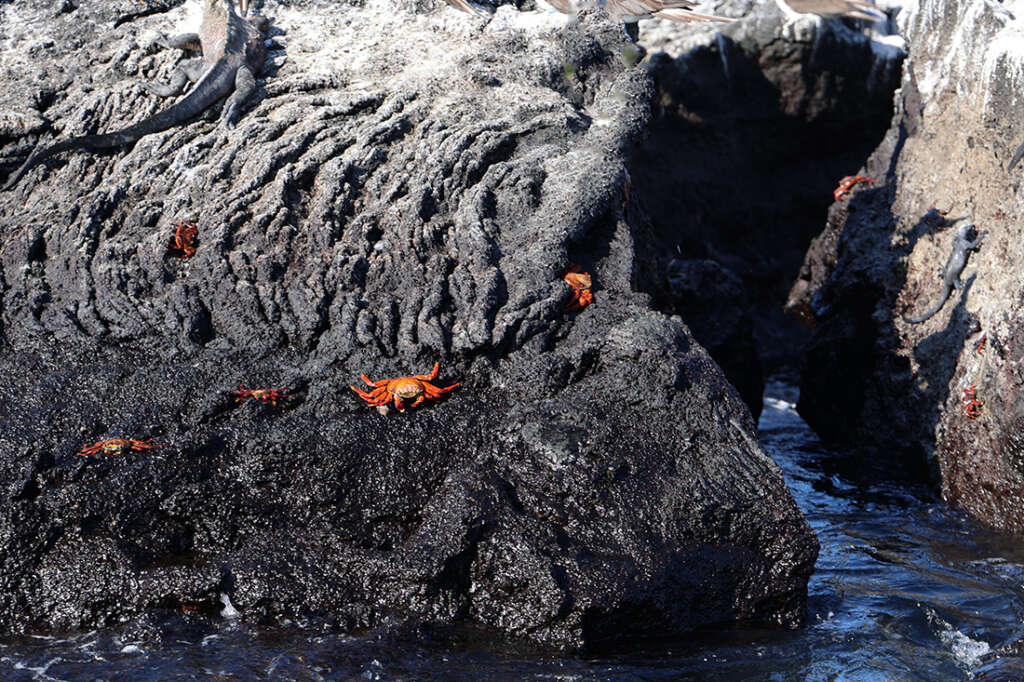
The dark black lava makes the vibrant red shells of the Sally Lightfoot crabs even more beautiful. Photo ©Dandelion Chandelier.
But its the creatures who live in this special place that make it feel full of fun, joy and ease.The bay at Punta Mangle is the point where the land meets the sea. And the nexus of these two environments creates an ecosystem perfect for birdlife. Sea birds, shorebirds and land birds all live in this cove. Alongside marine iguanas, sea lions and bright red Sally Lightfoot crabs. Somehow, there’s room on the rocks for all.
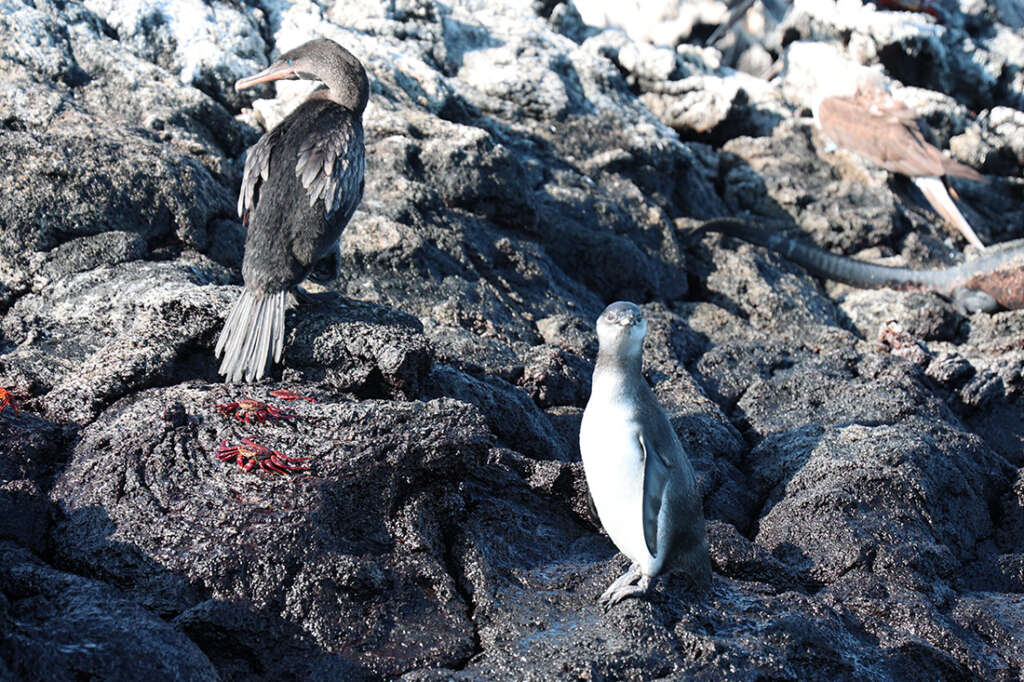
“Happy Island” on Punta Mengle in the Galapagos Islands. ©Dandelion Chandelier.
In fact, our expedition guide calls the rock where many of them choose to gather to bask in the sun “Happy Island.” He compares it to Miami Beach – “everyone’s on vacation and feeling fine.”
With that same exuberant spirit, have a look at some of our best photos and highlights from a recent vacation visit to Punta Mengle.
highlights and best photos of a morning at Punta Mengle in the Galapagos Islands.
1. The Blue-Footed Boobie.
While blue-footed boobies live on many islands in the Galapagos archipelago, Punta Mangle is without question one of the most photogenic places to see them. They occupy rocks, outcroppings and small islands in the bay, sharing them with frigatebirds, flightless cormorants, marine iguanas, sea lions and brown pelicans.
It’s hard to choose a favorite animal in the Galapagos Islands. There are so many unusual, beautiful and quirky creatures in this ecosystem that it’s probably not even reasonable to expect to be able to name just one. And yet . . . if we had to choose a favorite, for us it would be the Blue-Footed Boobie.
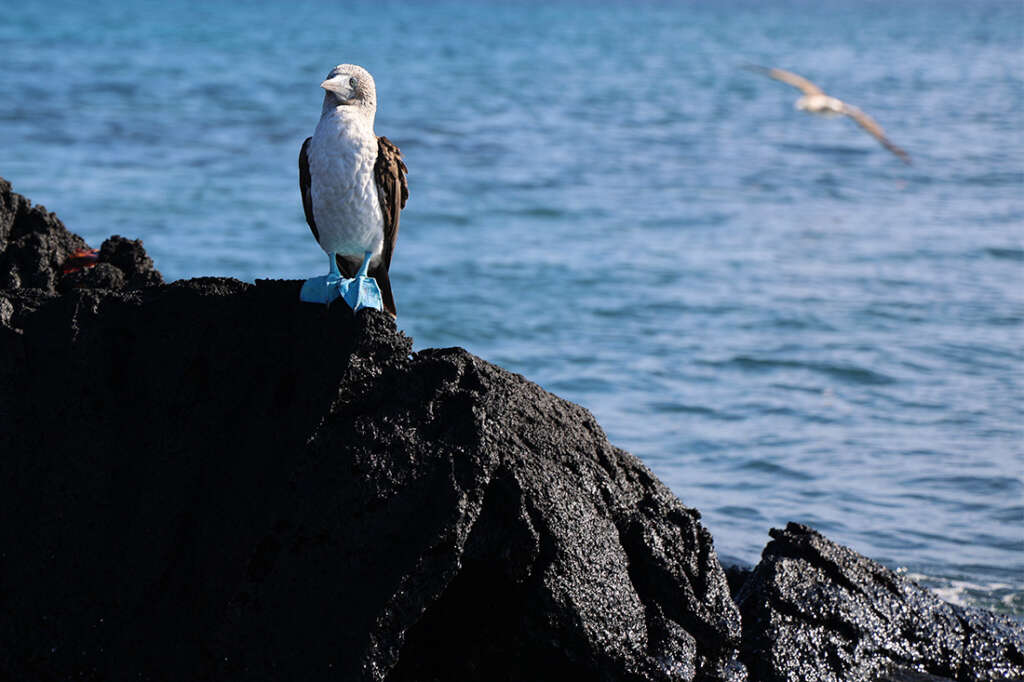
Blue-Footed Boobie in Punta Mengle in the Galapagos Islands. Photo ©Dandelion Chandelier.
the eternal charm of the blue-footed boobie
Blue-Footed Boobies have unforgettable feet, of course – and the healthier they are, the bluer their feet will be. They evolved this way because the bright blue color helps them attract mates, and signals that they’d be a good candidate.
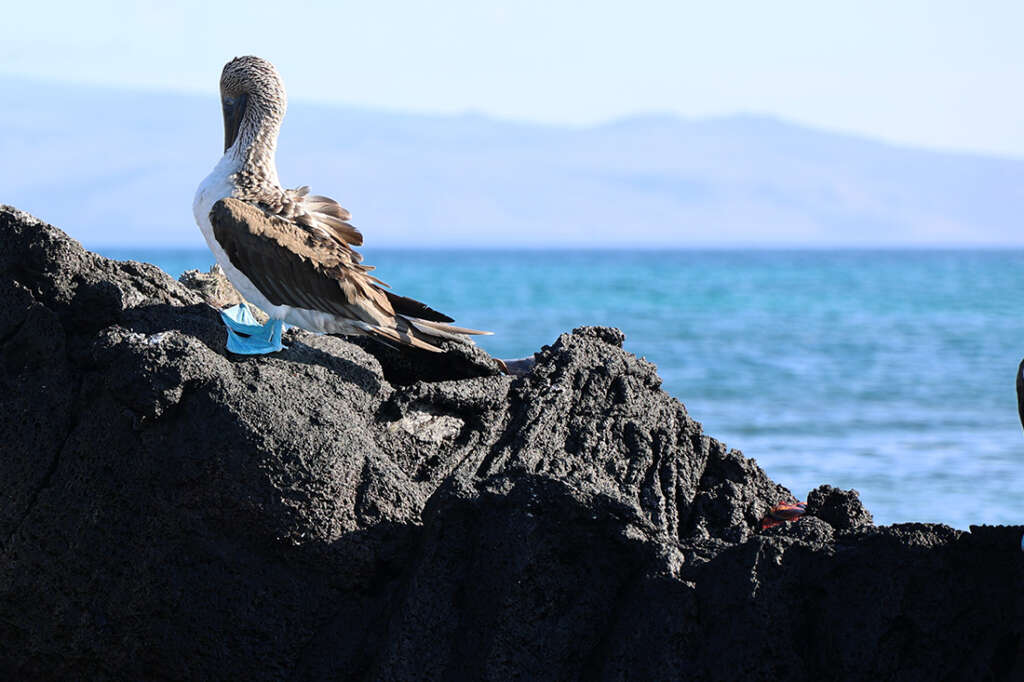
A Galapagos Islands Blue-Footed Boobie. Photo ©Dandelion Chandelier.
When they’re standing alone, or preening their feathers in small groups of two or three, the Blue-Footed Boobies of the Galapagos Islands can look serious – and even occasionally elegant.
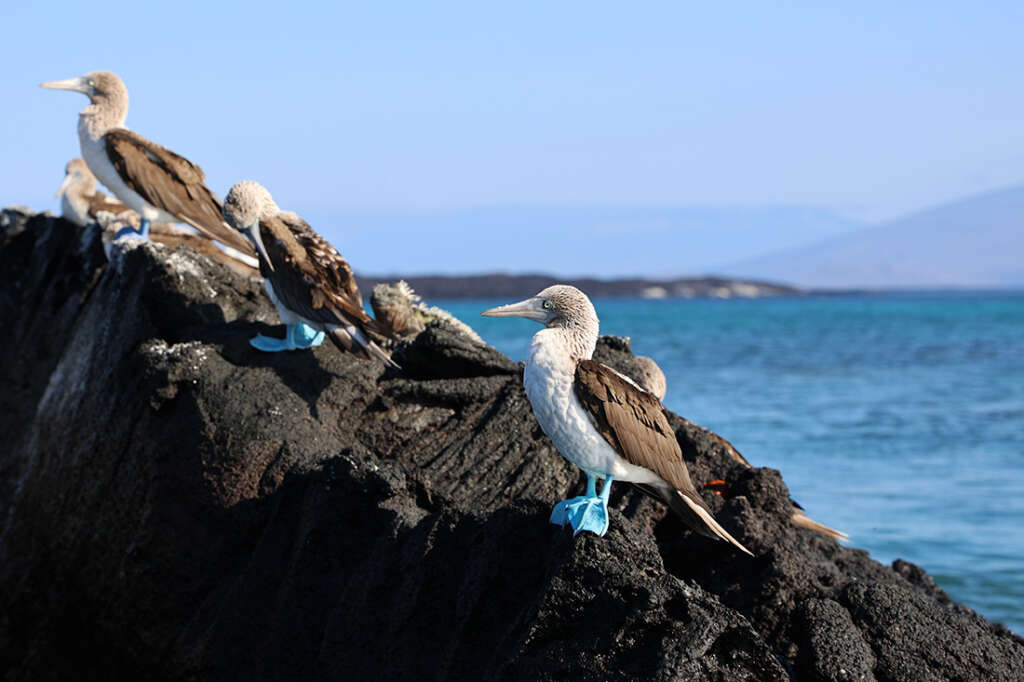
Photo ©Dandelion Chandelier.
They seem quite neighborly with the other birds, readily offering marine iguanas, Frigatebirds and Flightless Cormorants a space to hang out and chill.
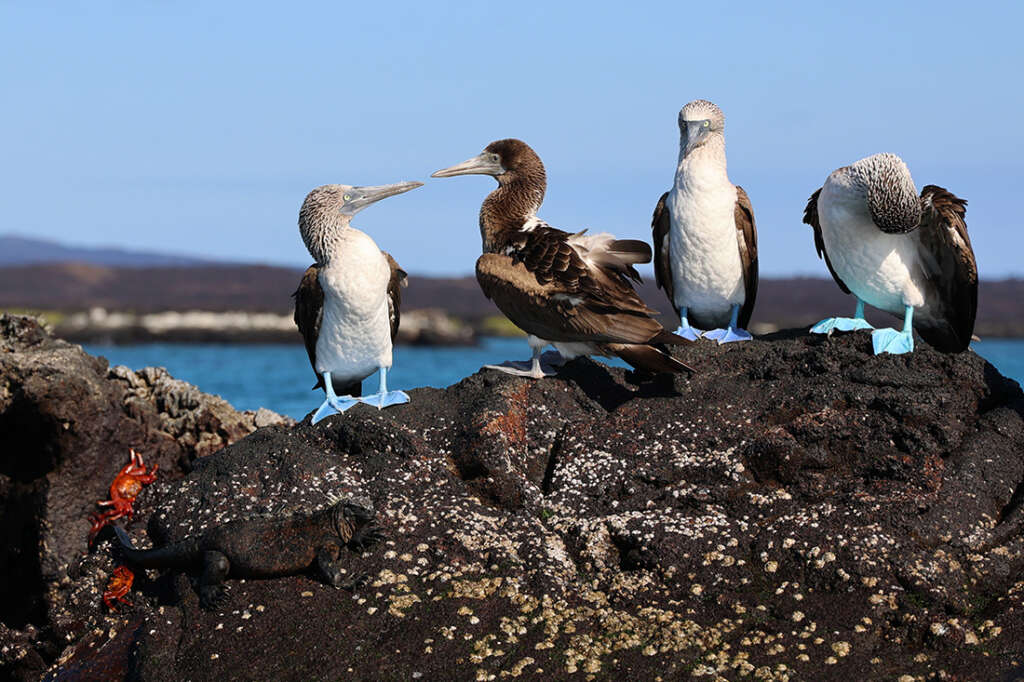
©Dandelion Chandelier.
However, the morning we were there, the Blue-Footed Boobie flock did seem to be having some kind of beef with the seal on the next rock over.
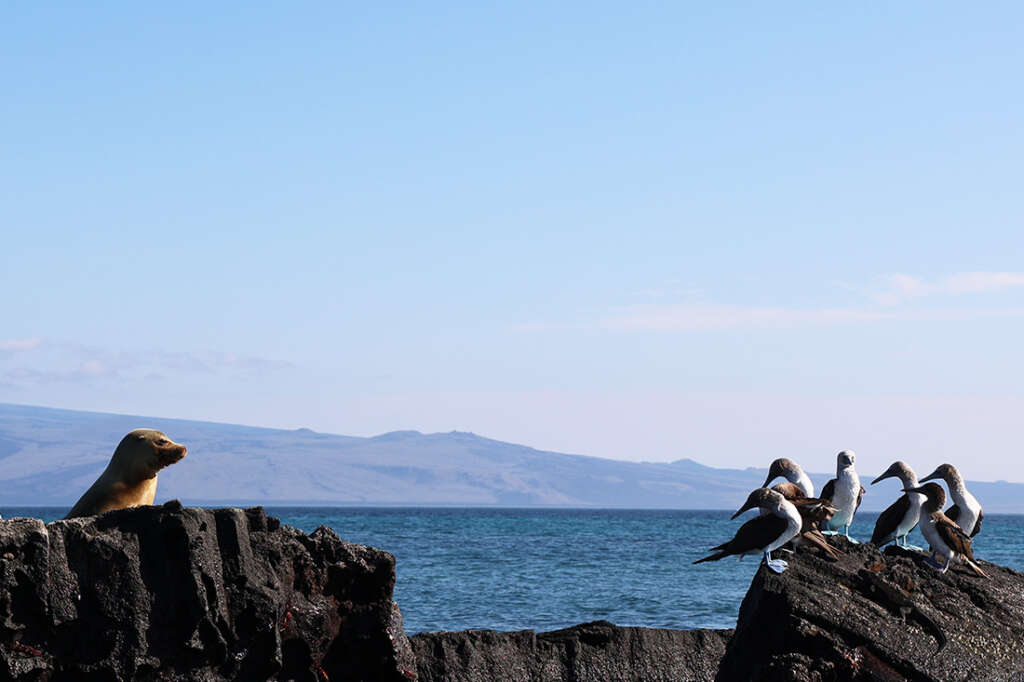
©Dandelion Chandelier.
Despite the occasional turf war, what makes us love Blue-Footed Boobies the most is their facial expressions when they’re in groups, which can be surprisingly, poignantly and comically human. Nowhere is this more present than on Punta Mengle on a bright morning.
Take, for example, this lineup on a rock in the middle of the bay. They look eerily reminiscent of a group of people waiting in the checkout line at a grocery store.
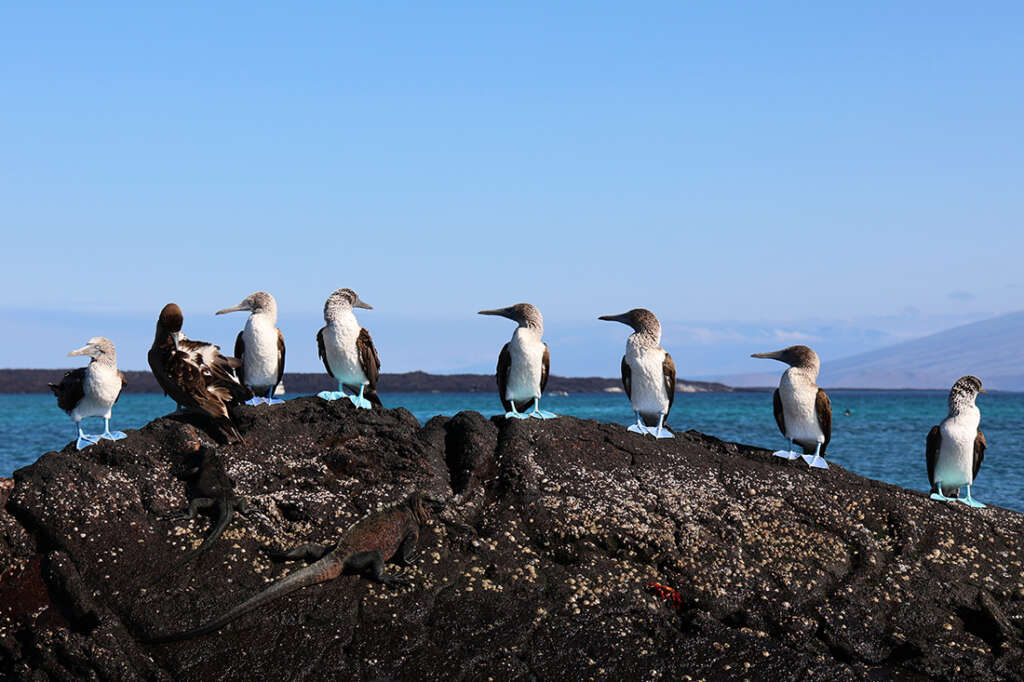
A collection of seabirds in the Galapagos Islands. Photo ©Dandelion Chandelier.
This group that reminded us of our morning commute, where’s there’s always that one guy who just won’t stop talking and leave us in peace.
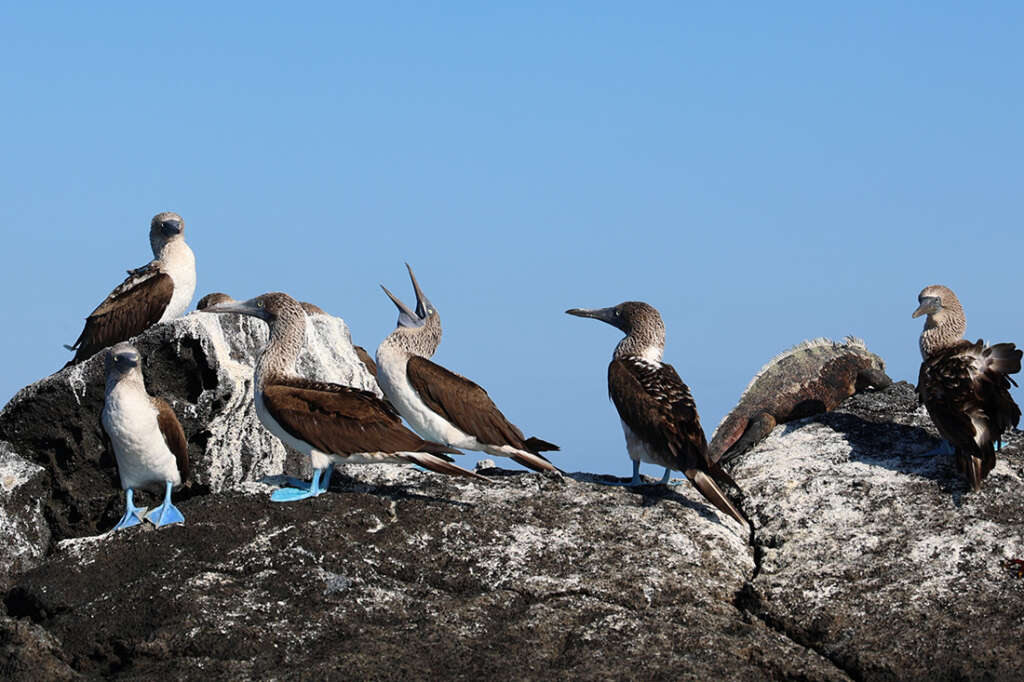
Photo ©Dandelion Chandelier.
Blue-Footed Boobie Flock on the Hunt
But the most dramatic site at Punta Mengle was when a flock of Blue-Footed Boobies took to the sky to hunt for prey in the waters below. They depart in a sudden flurry of feathers, everyone in the flock joining in.
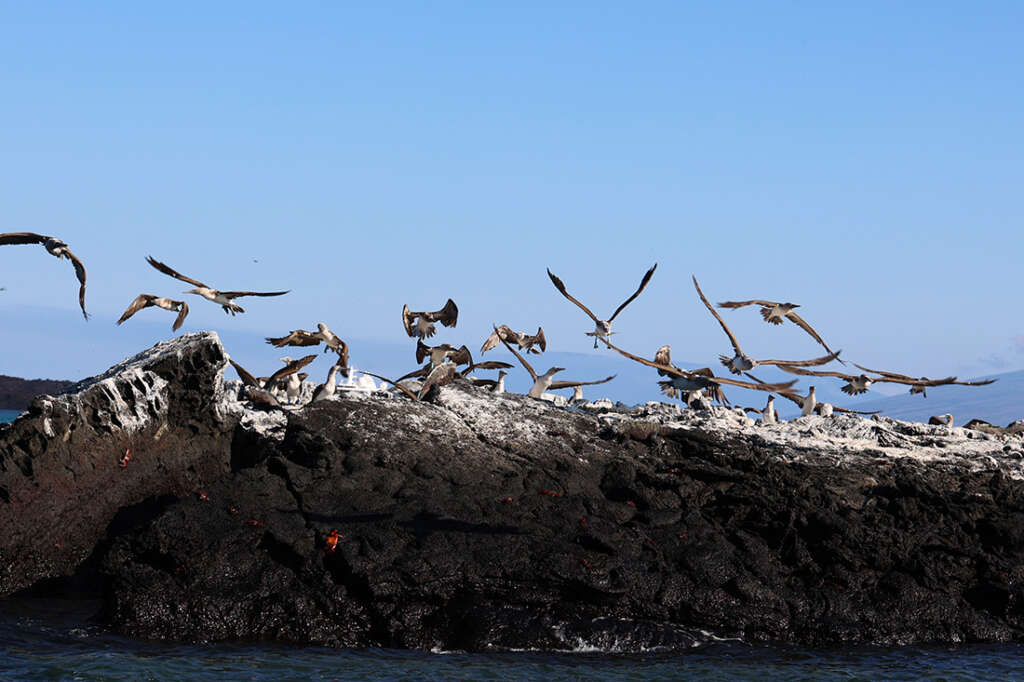
Blue-footed Boobies at Punta Mengle in the Galapagos Islands. ©Dandelion Chandelier.
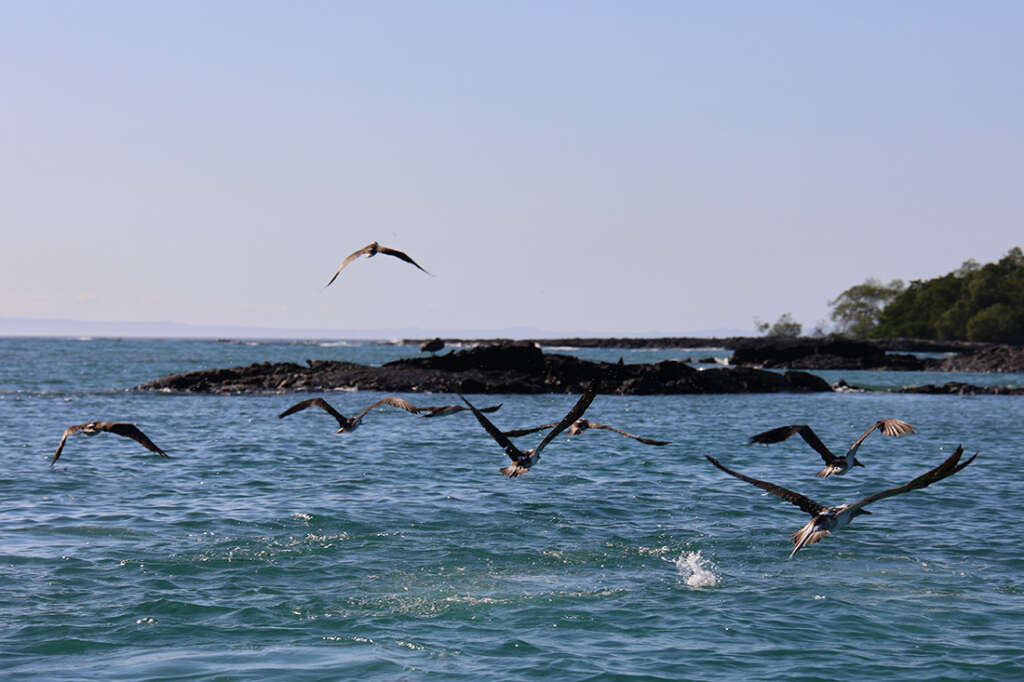
©Dandelion Chandelier.

©Dandelion Chandelier.
The Blue-Footed Boobies fly as a group, looking for prey in the waters below them. The, in an oddly beautiful and perfectly timed move, they all dive-bomb into the water to catch fish.
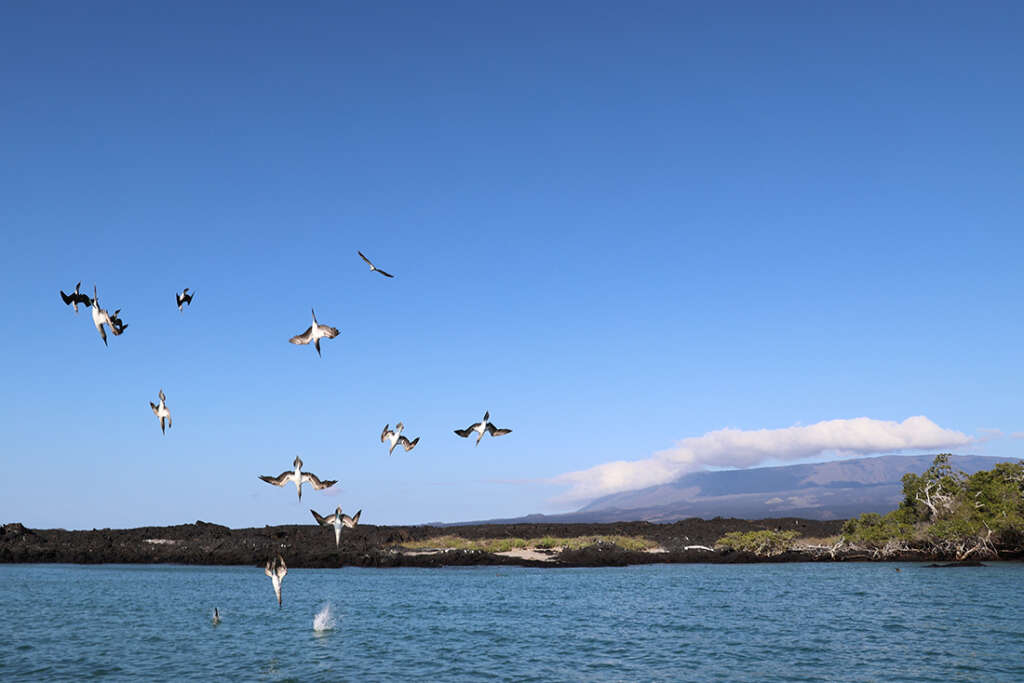
A flock of Blue-Footed Boobies in the Galapagos Islands diving for fish. ©Dandelion Chandelier.
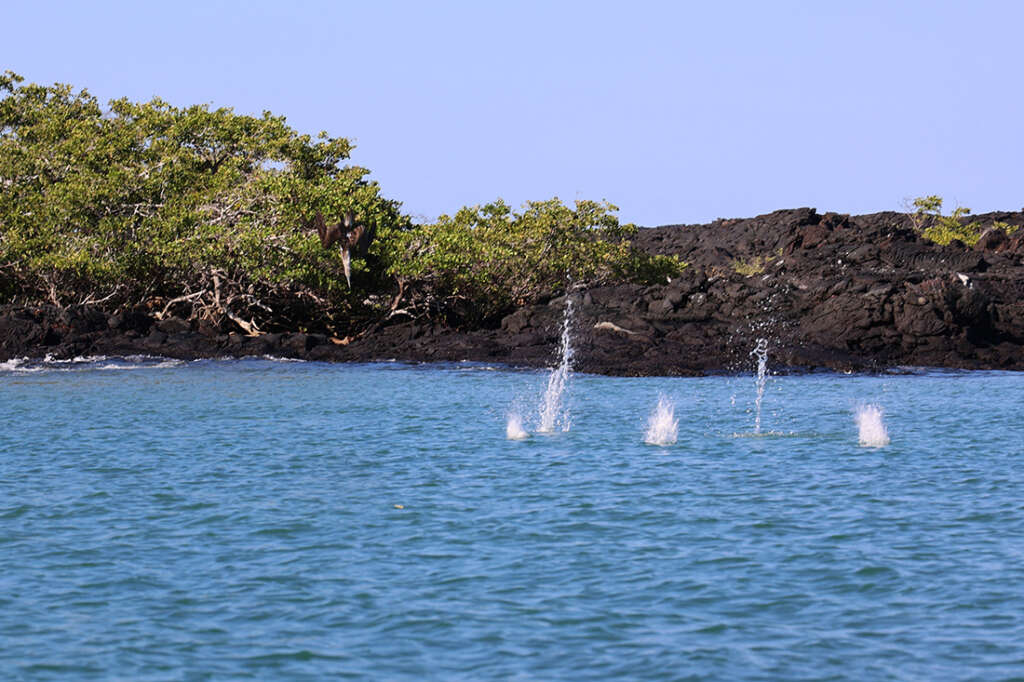
©Dandelion Chandelier.
It’s a remarkable level of coordination, grace and precision. If the group doesn’t catch a sufficient quantity of food, they quickly regroup and dive-bomb again.
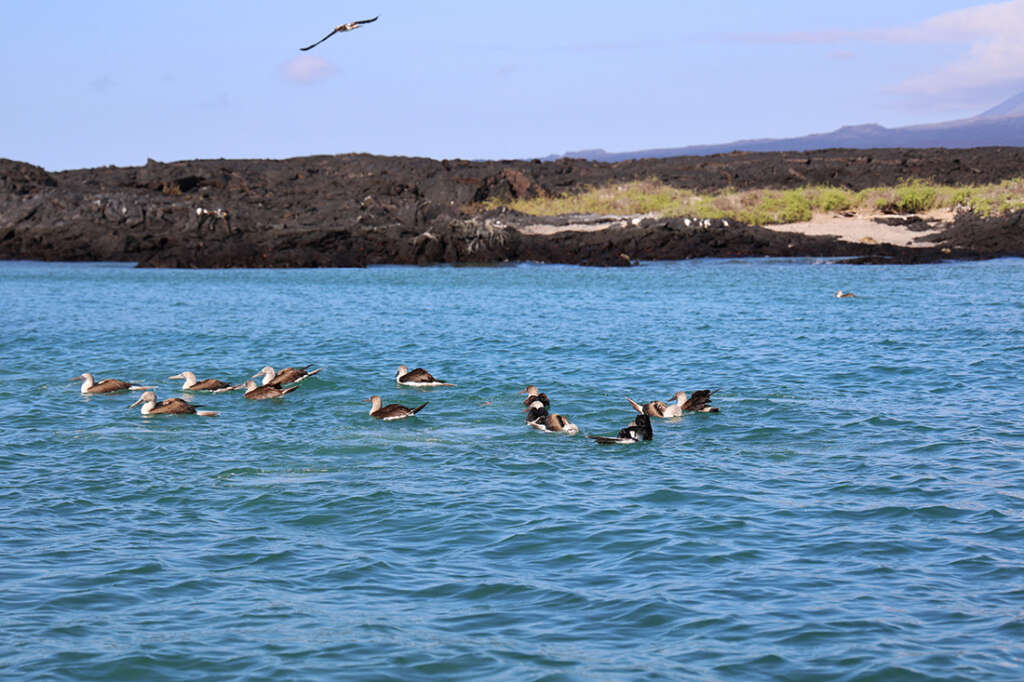
©Dandelion Chandelier.
the Galapagos penguin.
Of course, the Blue-Footed Boobies are not the only birds in Punte Mengle. We spotted at least one of the pint-sized Galapagos penguins. It’s odd to think of penguins as living in a tropical zone so close to the Equator. But we spotted them several times during the course of our vacation.
Like this adorable one in Punta Mengle.
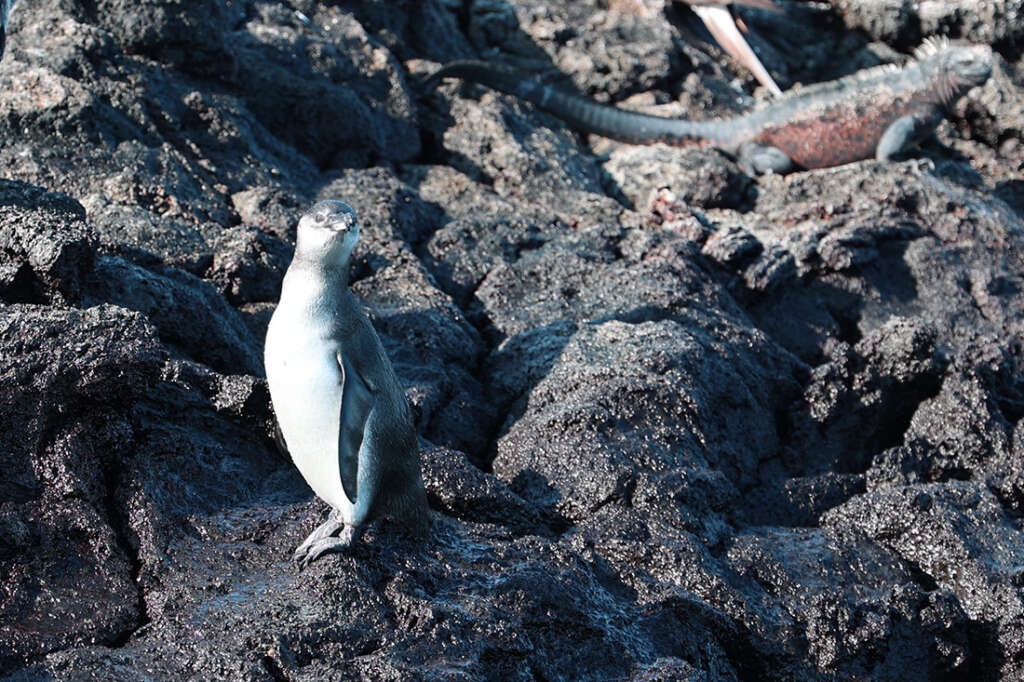
©Dandelion Chandelier.
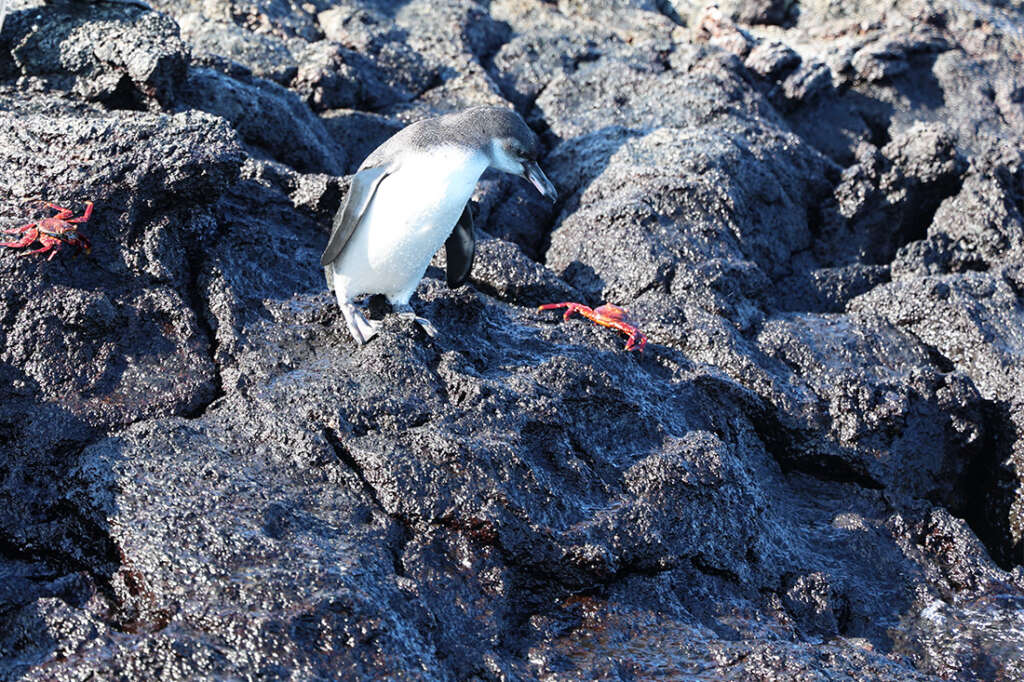
Photos from Punta Mangle in Galapagos Islands, with birds like Blue-Footed Boobies and penguins, plus sea lions and marine iguanas. ©Dandelion Chandelier.
They spend time sunning on the rocks and swimming, along with the marine iguanas and the other sea birds.
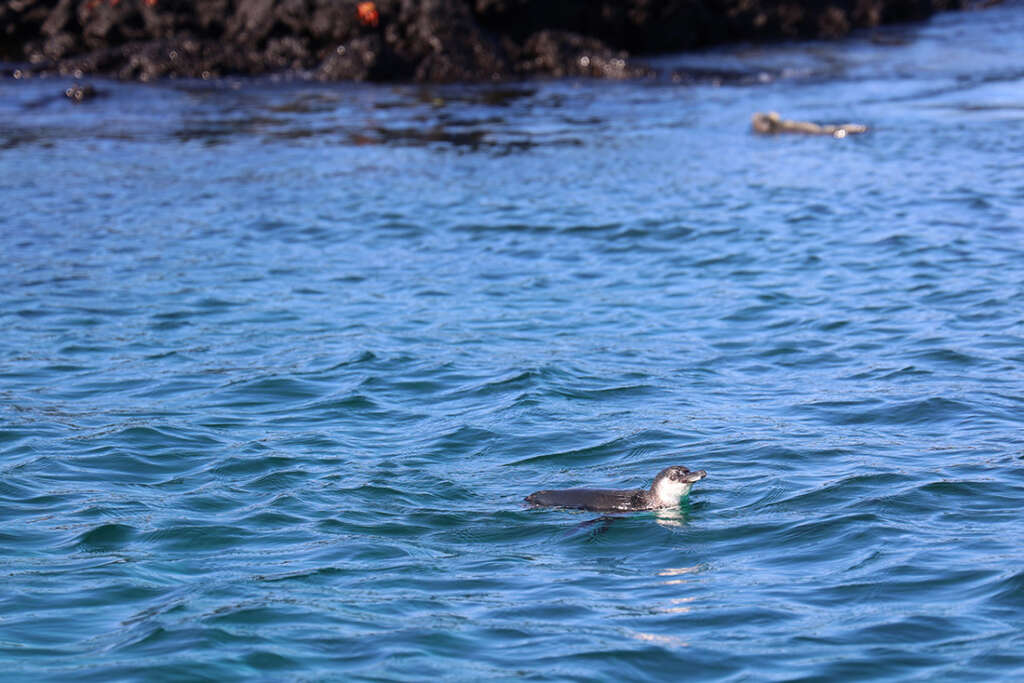
Galapagos penguin swimming in the waters of Punta Mengle. ©Dandelion Chandelier.
Flightless cormorants and frigatebirds.
While the Blue-Footed Boobies and the Galapagos penguins get all the glory, there are other beautiful birds in this part of the Galapagos Islands with their own interesting backstories.
Flightless Cormorants, for example, are the only species of cormorant to have evolved and thrived with no ability to fly. They’re expert swimmers and divers, and they’re one of the lesser known but fascinating sea birds in the archipelago.
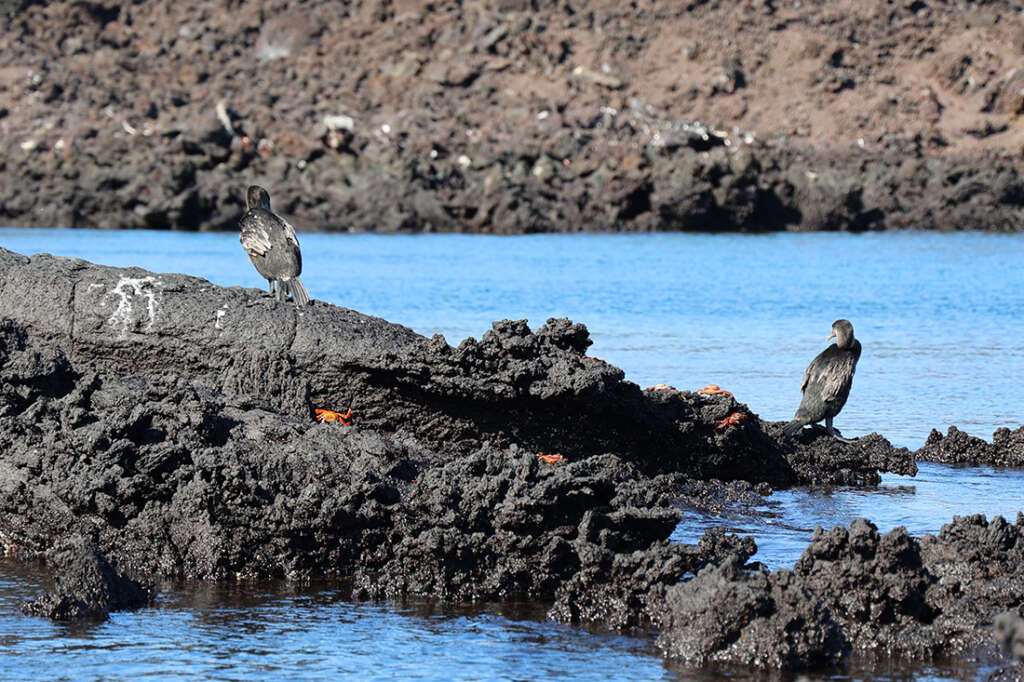
©Dandelion Chandelier.
Similarly, Frigatebirds have feathers in muted colors. But they’re very much a part of the lively ecosystem here.
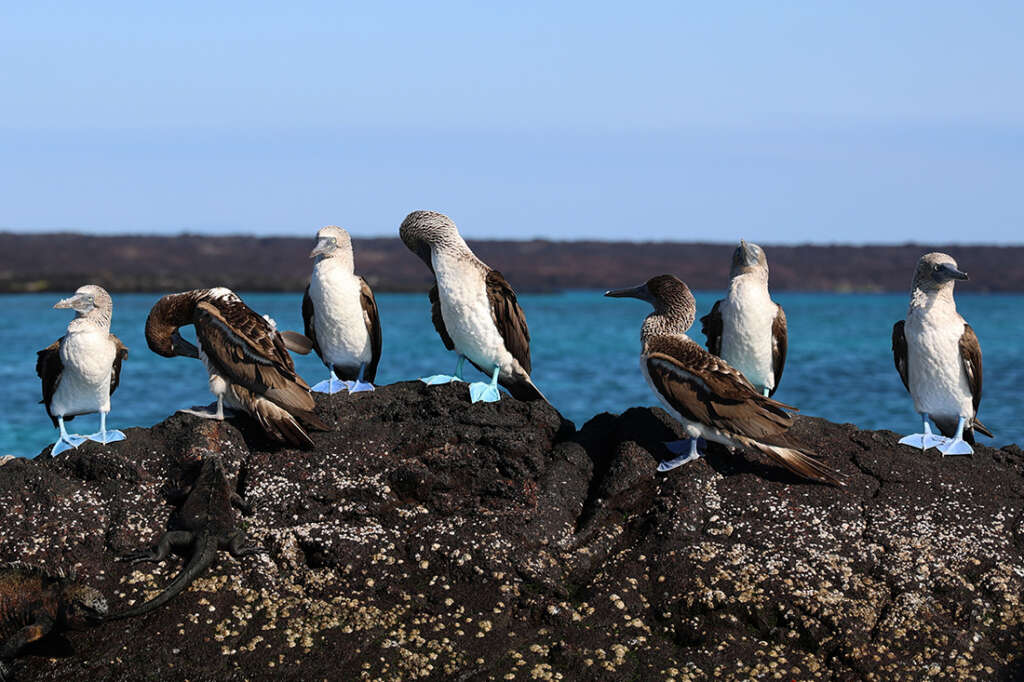
©Dandelion Chandelier.
Marine iguanas.
The shoreline is home to all three different species of mangrove: red, white and black. The root system of these trees serves as a nursery for many species of fish and reptiles, including juvenile sharks and green sea turtles. Marine iguanas are abundant, as they feed on the algae here.
As on other parts of Fernandina Island, Punta Mangle is home to thousands of marine iguanas. They like to cluster together on the rocks and shoreline of this bay, and can often be found swimming.
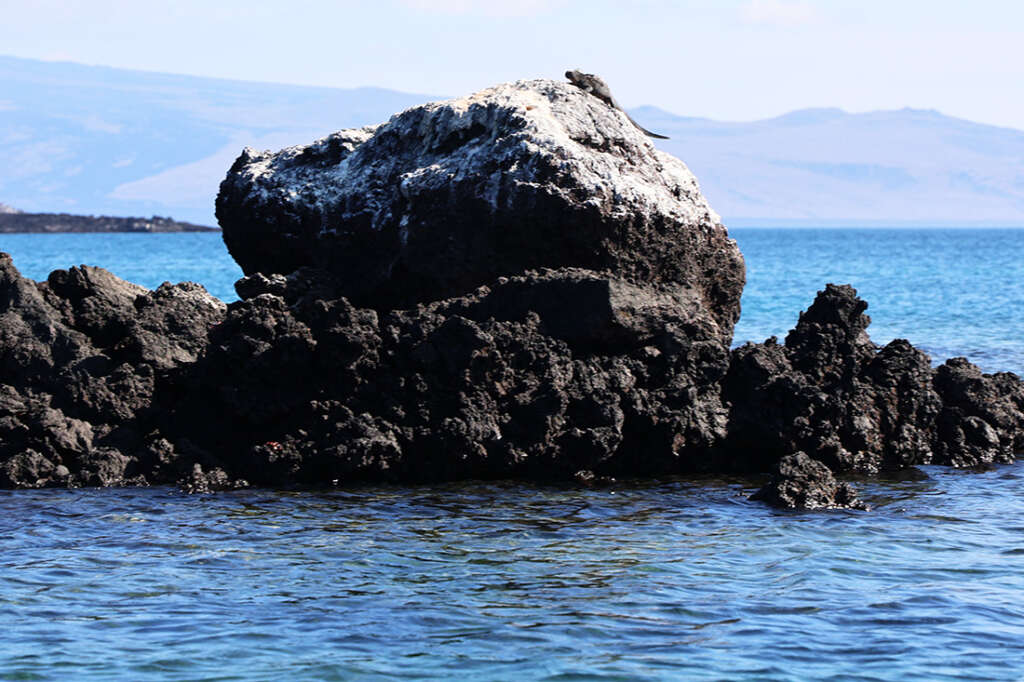
Photos from Punta Mangle in Galapagos Islands, with birds like Blue-Footed Boobies and penguins, plus sea lions and marine iguanas. ©Dandelion Chandelier.
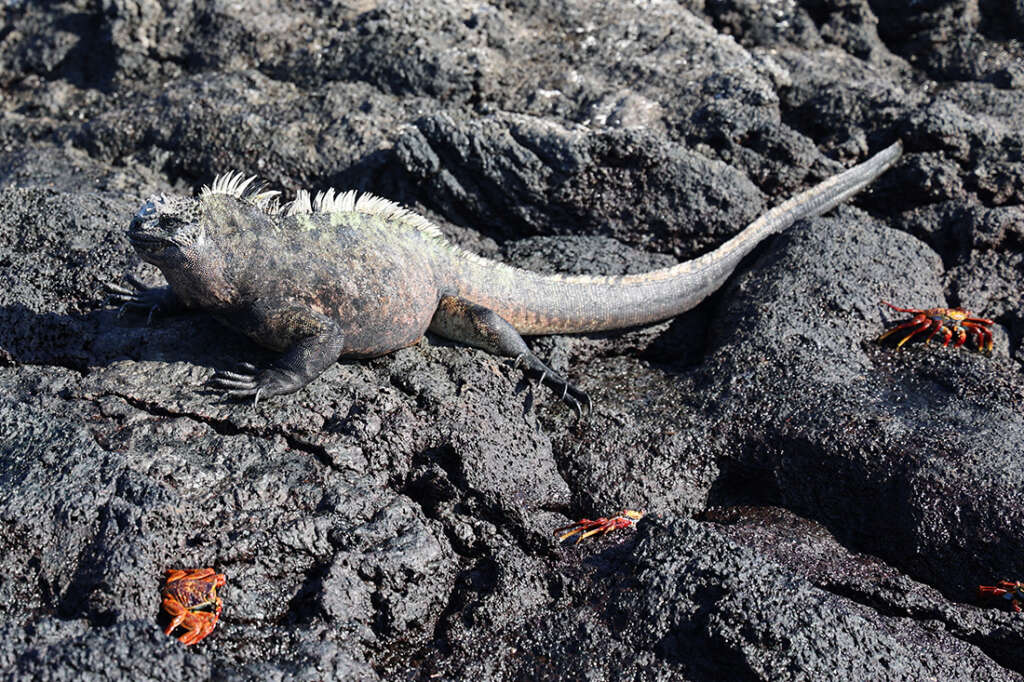
Marine iguana at Elizabeth Bay in the Galapagos Islands. ©Dandelion Chandelier.
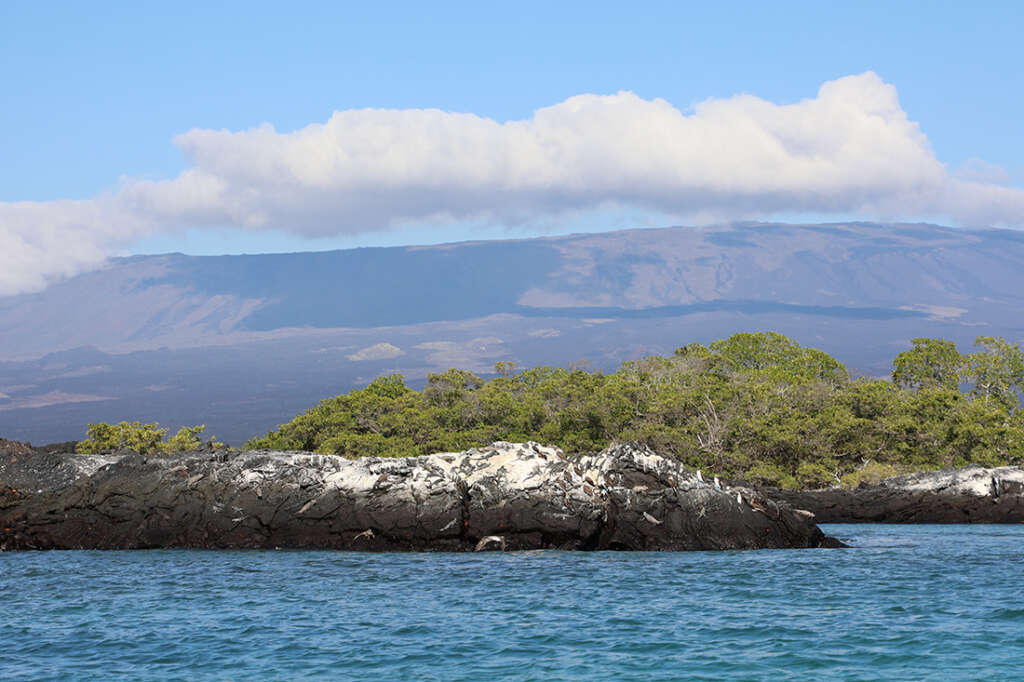
Look closely and you’ll see that this rock is covered with marine iguanas resting in the sun. ©Dandelion Chandelier.
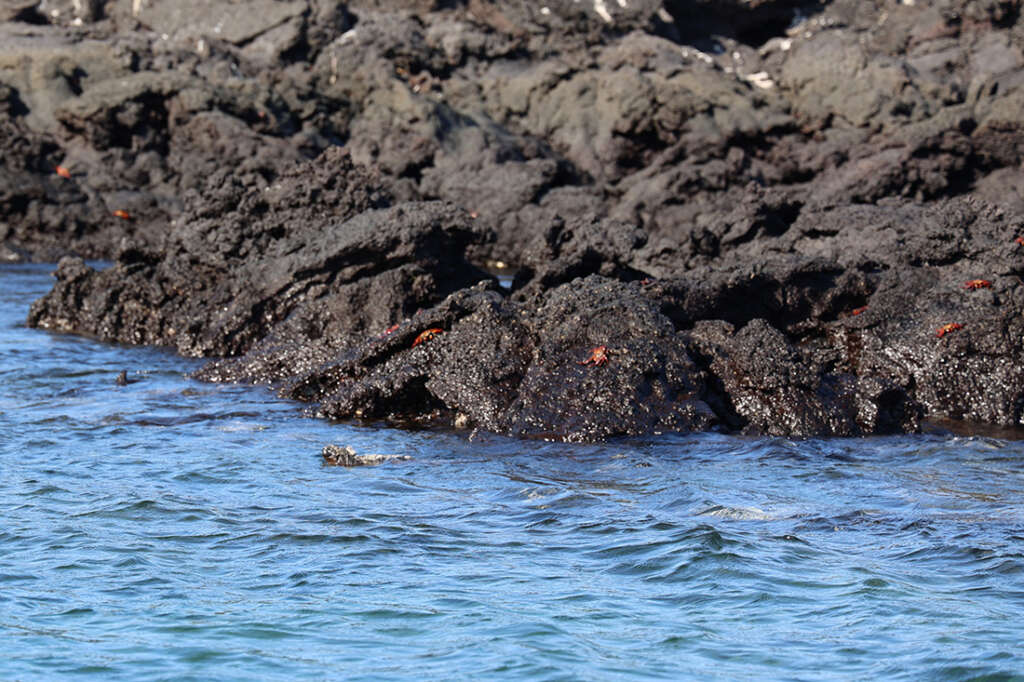
Marine iguana swimming in the waters of Punte Mengle in the Galapagos Islands. ©Dandelion Chandelier.
sea lions.
We spotted a juvenile male sea lion sunning himself on a rock adjacent to a group of Blue-Footed Boobies and Frigate Birds. His expressions and movements were priceless entertainment.
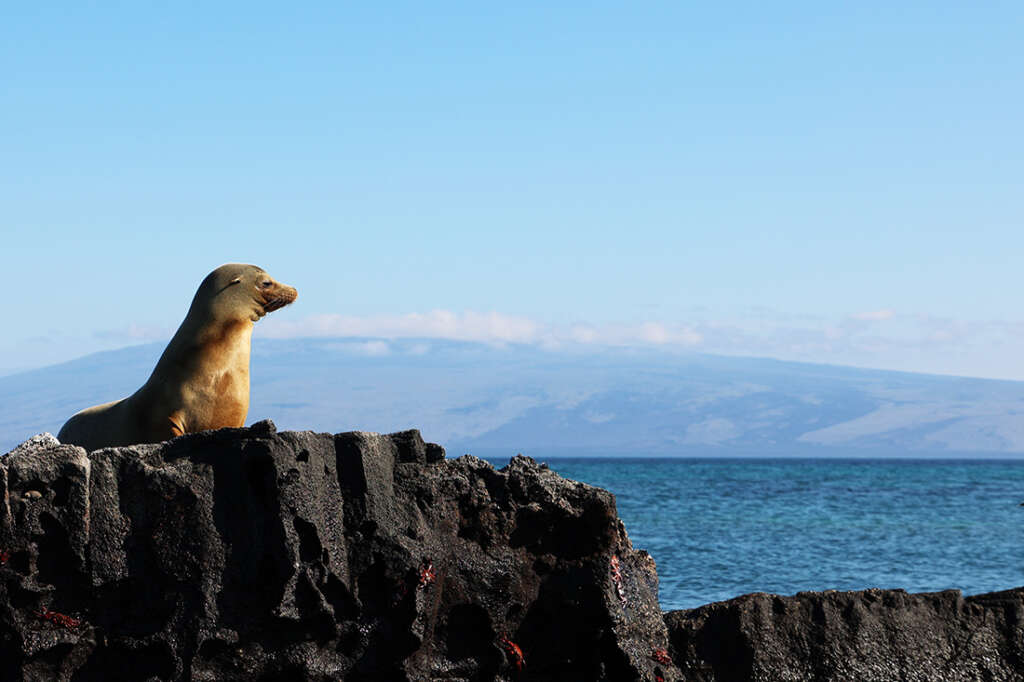
Sea lion on a rock in the bay at Punta Mengle in the Galapagos Islands. ©Dandelion Chandelier.
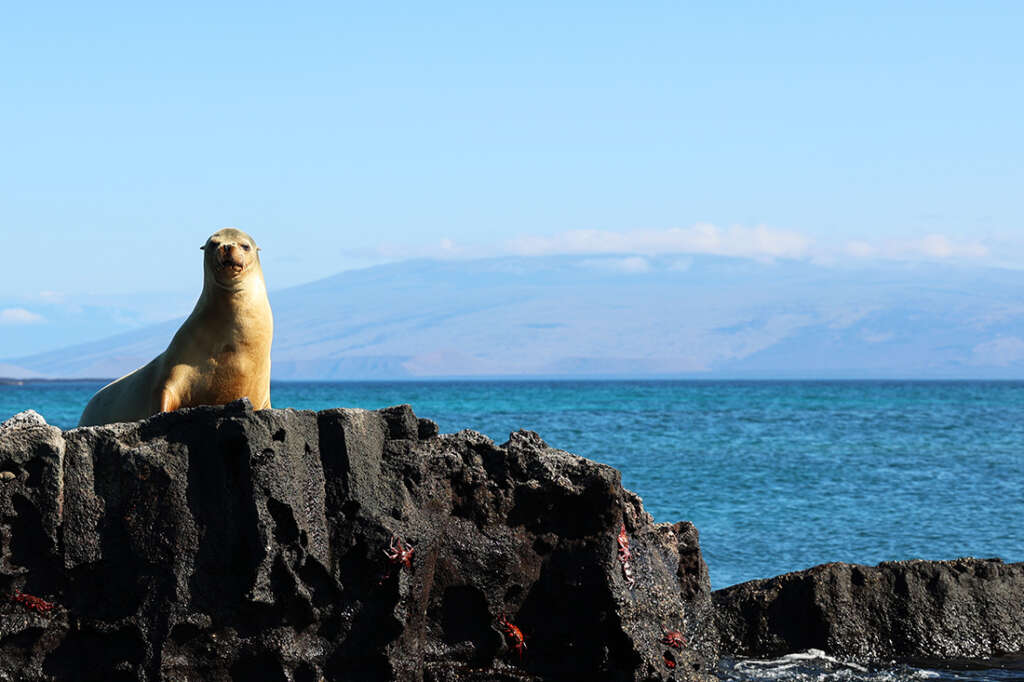
©Dandelion Chandelier.
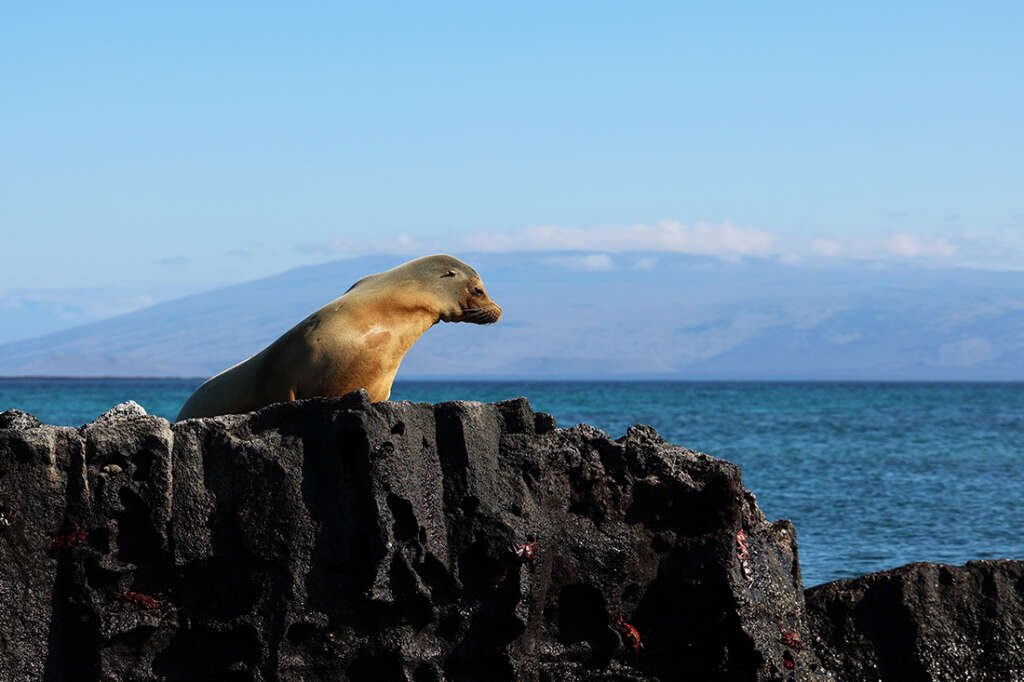
©Dandelion Chandelier.
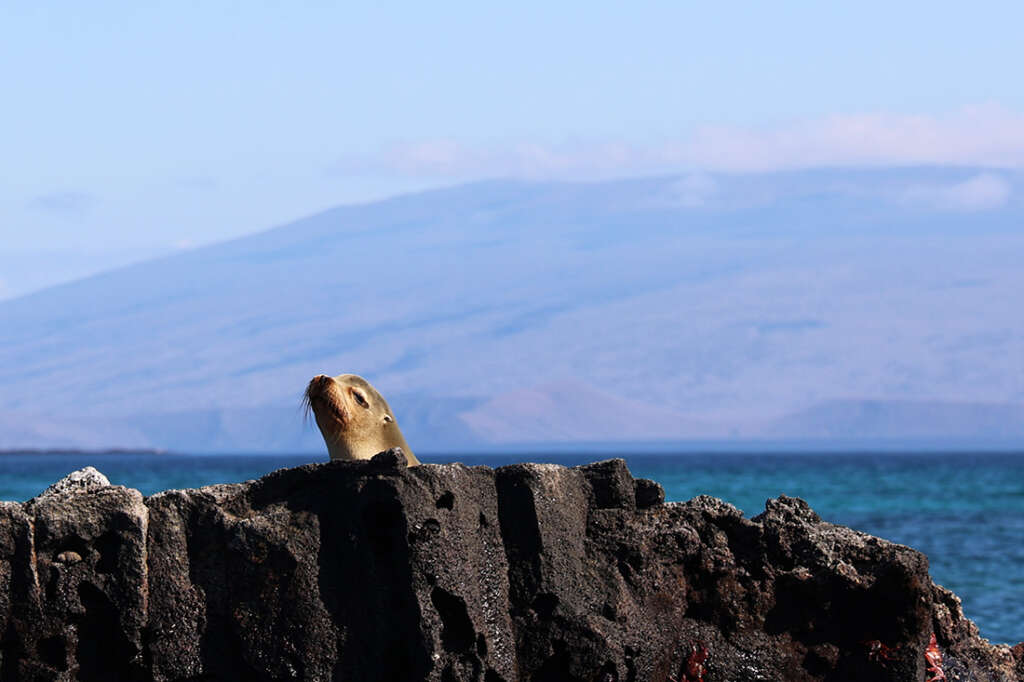
Galapagos Island sea lion. ©Dandelion Chandelier.
Here, he seems to be making an existential cry for help and meaning. Or maybe he just wants a sandwich?
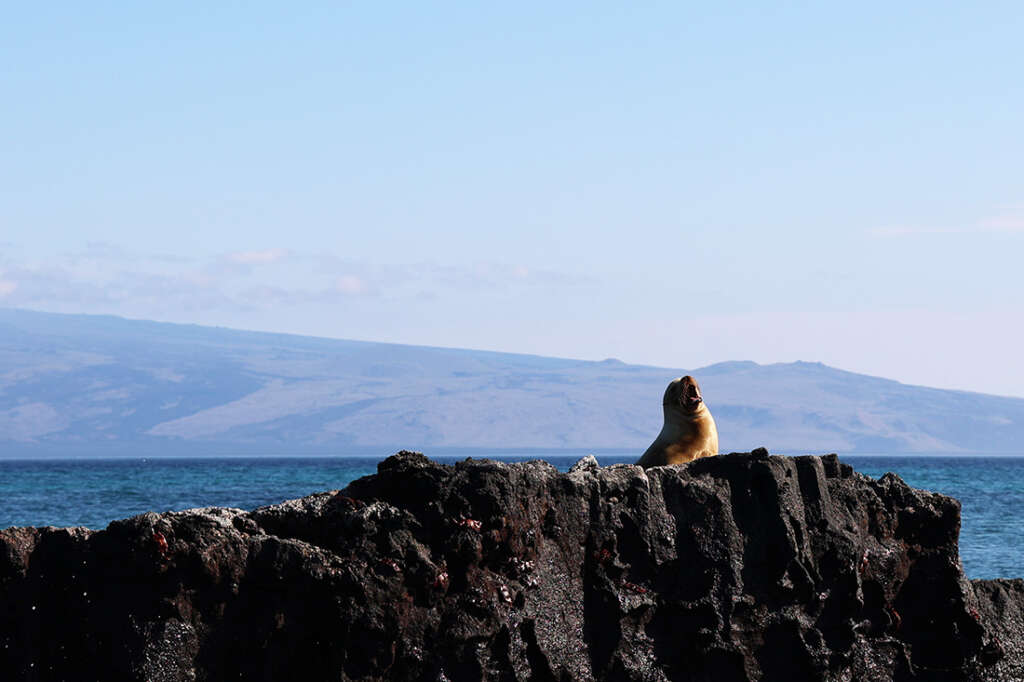
©Dandelion Chandelier.
birds of a feather on punta mangle in the galapagos islands
Those are some of our best photos from Punta Mangle on Fernandina Island in the Galapagos archipelago, home to Blue-Footed Boobies, Flightless Cormorants, penguins, sea lions and more. If you have the chance to visit, definitely do. It’s one of the most beautiful places we’ve ever seen.
